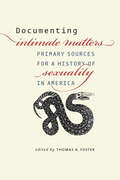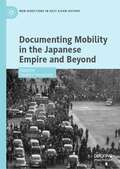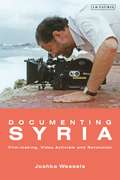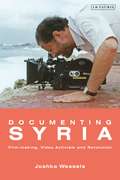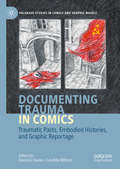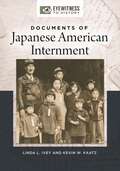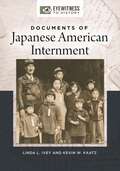- Table View
- List View
Documenting Impossible Realities: Ethnography, Memory, and the As If
by Susan Bibler Coutin Barbara YngvessonDocumenting Impossible Realities explores the limitations of conventional accounts through which belonging is documented, focusing on the experiences of adoptees, deportees, migrants, and other exilic populations. Susan Bibler Coutin and Barbara Yngvesson speak to the current historical moment in which the dichotomy between an "above ground" inhabited by dominant groups and an "underground" to which unauthorized immigrants, political exiles, and transnational adoptees are relegated cannot be sustained. This dichotomy was made possible by the illusion that some people do not belong, that some forms of kin are not real, or that certain ways of knowing do not count. To examine accounts that challenge such illusions, Coutin and Yngvesson focus on the spaces between groups, where difference is constituted and where the potential for new forms of relationship may be realized. By juxtaposing and moving between entangled realities and modes of expression, Documenting Impossible Realities conveys the emotional experience of oscillating between being here and gone, legitimate and treated as counterfeit.
Documenting Intimate Matters: Primary Sources for a History of Sexuality in America
by Thomas A. FosterOver time, sexuality in America has changed dramatically. Frequently redefined and often subject to different systems of regulation, it has been used as a means of control; it has been a way to understand ourselves and others; and it has been at the center of fierce political storms, including some of the most crucial changes in civil rights in the last decade. Edited by Thomas A. Foster, Documenting Intimate Matters features seventy-two documents that collectively highlight the broad diversity inherent in the history of American sexuality. Complementing the third edition of Intimate Matters, by John D’Emilio and Estelle B. Freedman—often hailed as the definitive survey of sexual history in America—the multiple narratives presented by these documents reveal the complexity of this subject in US history. The historical moments captured in this volume will show that, contrary to popular misconception, the history of sexuality is not a simple story of increased freedoms and sexual liberation, but an ongoing struggle between change and continuity.
Documenting Intimate Matters: Primary Sources for a History of Sexuality in America
by Thomas A. FosterOver time, sexuality in America has changed dramatically. Frequently redefined and often subject to different systems of regulation, it has been used as a means of control; it has been a way to understand ourselves and others; and it has been at the center of fierce political storms, including some of the most crucial changes in civil rights in the last decade. Edited by Thomas A. Foster, Documenting Intimate Matters features seventy-two documents that collectively highlight the broad diversity inherent in the history of American sexuality. Complementing the third edition of Intimate Matters, by John D’Emilio and Estelle B. Freedman—often hailed as the definitive survey of sexual history in America—the multiple narratives presented by these documents reveal the complexity of this subject in US history. The historical moments captured in this volume will show that, contrary to popular misconception, the history of sexuality is not a simple story of increased freedoms and sexual liberation, but an ongoing struggle between change and continuity.
Documenting Intimate Matters: Primary Sources for a History of Sexuality in America
by Thomas A. FosterOver time, sexuality in America has changed dramatically. Frequently redefined and often subject to different systems of regulation, it has been used as a means of control; it has been a way to understand ourselves and others; and it has been at the center of fierce political storms, including some of the most crucial changes in civil rights in the last decade. Edited by Thomas A. Foster, Documenting Intimate Matters features seventy-two documents that collectively highlight the broad diversity inherent in the history of American sexuality. Complementing the third edition of Intimate Matters, by John D’Emilio and Estelle B. Freedman—often hailed as the definitive survey of sexual history in America—the multiple narratives presented by these documents reveal the complexity of this subject in US history. The historical moments captured in this volume will show that, contrary to popular misconception, the history of sexuality is not a simple story of increased freedoms and sexual liberation, but an ongoing struggle between change and continuity.
Documenting Intimate Matters: Primary Sources for a History of Sexuality in America
by Thomas A. Foster John D'EmilioOver time, sexuality in America has changed dramatically. Frequently redefined and often subject to different systems of regulation, it has been used as a means of control; it has been a way to understand ourselves and others; and it has been at the center of fierce political storms, including some of the most crucial changes in civil rights in the last decade. Edited by Thomas A. Foster, Documenting Intimate Matters features seventy-two documents that collectively highlight the broad diversity inherent in the history of American sexuality. Complementing the third edition of Intimate Matters, by John D’Emilio and Estelle B. Freedman—often hailed as the definitive survey of sexual history in America—the multiple narratives presented by these documents reveal the complexity of this subject in US history. The historical moments captured in this volume will show that, contrary to popular misconception, the history of sexuality is not a simple story of increased freedoms and sexual liberation, but an ongoing struggle between change and continuity.
Documenting Intimate Matters: Primary Sources for a History of Sexuality in America
by Thomas A. Foster John D'Emilio Estelle B. FreedmanOver time, sexuality in America has changed dramatically. Frequently redefined and often subject to different systems of regulation, it has been used as a means of control; it has been a way to understand ourselves and others; and it has been at the center of fierce political storms, including some of the most crucial changes in civil rights in the last decade. Edited by Thomas A. Foster, Documenting Intimate Matters features seventy-two documents that collectively highlight the broad diversity inherent in the history of American sexuality. Complementing the third edition of Intimate Matters, by John D’Emilio and Estelle B. Freedman—often hailed as the definitive survey of sexual history in America—the multiple narratives presented by these documents reveal the complexity of this subject in US history. The historical moments captured in this volume will show that, contrary to popular misconception, the history of sexuality is not a simple story of increased freedoms and sexual liberation, but an ongoing struggle between change and continuity.
Documenting Intimate Matters: Primary Sources for a History of Sexuality in America
by Thomas A. Foster John D'Emilio Estelle B. FreedmanOver time, sexuality in America has changed dramatically. Frequently redefined and often subject to different systems of regulation, it has been used as a means of control; it has been a way to understand ourselves and others; and it has been at the center of fierce political storms, including some of the most crucial changes in civil rights in the last decade. Edited by Thomas A. Foster, Documenting Intimate Matters features seventy-two documents that collectively highlight the broad diversity inherent in the history of American sexuality. Complementing the third edition of Intimate Matters, by John D’Emilio and Estelle B. Freedman—often hailed as the definitive survey of sexual history in America—the multiple narratives presented by these documents reveal the complexity of this subject in US history. The historical moments captured in this volume will show that, contrary to popular misconception, the history of sexuality is not a simple story of increased freedoms and sexual liberation, but an ongoing struggle between change and continuity.
Documenting Mobility in the Japanese Empire and Beyond (New Directions in East Asian History)
by Takahiro YamamotoThis book tackles the question of border control in and around imperial Japan in the first half of the twentieth century, with a specific focus on its documentation regime. It explores the institutional development, media and literary discourses, and on[1]the-ground practices of documentary identification in the Japanese empire and the places visited by its subjects. The contributing authors, covering such regions as Korea, Manchuria, Taiwan, Siberia, Australia, and the United States, place the question of individual identity in the eyes of the respective governments in dialogue with the global developments of the identification and mobility control practices. The chapters suggest the importance of focusing more than previously on the narrative of individual identification, not as a tool for creating nation states but as a tool for generating, strengthening, and maintaining asymmetrical relationships between people of different socioeconomic backgrounds who moved in and out of empires. This book joins the effort in the recent scholarship in migration history to highlight experiences of migrants beyond the transatlantic world, and that in East Asian history to investigate the space and connections beyond the boundaries of the nation states. By bringing together the analyses on the trans-Pacific mobility and Japan’s imperial expansion and its aftermath in East Asia, it shows a complex interplay between state power and moving individuals, two forces whose relationships went far beyond simple competition.
Documenting Syria: Film-making, Video Activism and Revolution
by Josepha Ivanka WesselsSyria is now one of the most important countries in the world for the documentary film industry. Since the 1970s, Syrian cinema masters played a defining role in avant-garde filmmaking and political dissent against authoritarianism. After the outbreak of violence in 2011, an estimated 500,000 video clips were uploaded making it one of the first YouTubed revolutions in history. This book is the first history of documentary filmmaking in Syria. Based on extensive media ethnography and in-depth interviews with Syrian filmmakers in exile, the book offers an archival analysis of the documentary work by masters of Syrian cinema, such as Nabil Maleh, Ossama Mohammed, Mohammed Malas, Hala Al Abdallah, Hanna Ward, Ali Atassi and Omar Amiralay. Joshka Wessels traces how the works of these filmmakers became iconic for a new generation of filmmakers at the beginning of the 21st century and maps the radical change in the documentary landscape after the revolution of 2011. Special attention is paid to the late Syrian filmmaker and pro-democracy activist, Bassel Shehadeh, and the video-resistance from Aleppo and Raqqa against the regime of President Bashar al-Assad and the Islamic State. An essential resource for scholars of Syrian Studies, this book will also be highly relevant to the fields of media & conflict research, anthropology and political science.
Documenting Syria: Film-making, Video Activism and Revolution
by Josepha Ivanka WesselsSyria is now one of the most important countries in the world for the documentary film industry. Since the 1970s, Syrian cinema masters played a defining role in avant-garde filmmaking and political dissent against authoritarianism. After the outbreak of violence in 2011, an estimated 500,000 video clips were uploaded making it one of the first YouTubed revolutions in history. This book is the first history of documentary filmmaking in Syria. Based on extensive media ethnography and in-depth interviews with Syrian filmmakers in exile, the book offers an archival analysis of the documentary work by masters of Syrian cinema, such as Nabil Maleh, Ossama Mohammed, Mohammed Malas, Hala Al Abdallah, Hanna Ward, Ali Atassi and Omar Amiralay. Joshka Wessels traces how the works of these filmmakers became iconic for a new generation of filmmakers at the beginning of the 21st century and maps the radical change in the documentary landscape after the revolution of 2011. Special attention is paid to the late Syrian filmmaker and pro-democracy activist, Bassel Shehadeh, and the video-resistance from Aleppo and Raqqa against the regime of President Bashar al-Assad and the Islamic State. An essential resource for scholars of Syrian Studies, this book will also be highly relevant to the fields of media & conflict research, anthropology and political science.
Documenting the Visual Arts
by Roger HallasBringing together an international range of scholars, as well as filmmakers and curators, this book explores the rich variety in form and content of the contemporary art documentary. Since their emergence in the late 1940s as a distinct genre, documentaries about the visual arts have made significant contributions to art education, public television, and documentary filmmaking, yet they have received little scholarly attention from either art history or film studies. Documenting the Visual Arts brings that attention to the fore. Whether considering documentaries about painting, sculpture, photography, performance art, site-specific installation, or fashion, the chapters of this book engage with the key question of intermediality: how film can reframe other visual arts through its specific audio-visual qualities, in order to generate new ways of understanding those arts. The essays illuminate furthermore how art documentaries raise some of the most critical issues of the contemporary global art world, specifically the discourse of the artist, the dynamics of documentation, and the visuality of the museum. Contributors discuss documentaries by filmmakers such as Frederick Wiseman, Lynn Hershman Leeson, Jia Zhangke, and Trisha Ziff, and about artists such as Michael Heizer, Ai Weiwei, Do Ho Suh, and Marina Abramović. This collection of new international and interdisciplinary scholarship on visual art documentaries is ideal for students and scholars of visual arts and filmmaking, as well as art history, arts education, and media studies.
Documenting the Visual Arts
by Roger HallasBringing together an international range of scholars, as well as filmmakers and curators, this book explores the rich variety in form and content of the contemporary art documentary. Since their emergence in the late 1940s as a distinct genre, documentaries about the visual arts have made significant contributions to art education, public television, and documentary filmmaking, yet they have received little scholarly attention from either art history or film studies. Documenting the Visual Arts brings that attention to the fore. Whether considering documentaries about painting, sculpture, photography, performance art, site-specific installation, or fashion, the chapters of this book engage with the key question of intermediality: how film can reframe other visual arts through its specific audio-visual qualities, in order to generate new ways of understanding those arts. The essays illuminate furthermore how art documentaries raise some of the most critical issues of the contemporary global art world, specifically the discourse of the artist, the dynamics of documentation, and the visuality of the museum. Contributors discuss documentaries by filmmakers such as Frederick Wiseman, Lynn Hershman Leeson, Jia Zhangke, and Trisha Ziff, and about artists such as Michael Heizer, Ai Weiwei, Do Ho Suh, and Marina Abramović. This collection of new international and interdisciplinary scholarship on visual art documentaries is ideal for students and scholars of visual arts and filmmaking, as well as art history, arts education, and media studies.
Documenting Transnational Migration: Jordanian Men Working and Studying in Europe, Asia and North America (New Directions in Anthropology #25)
by Richard T. AntounMost studies on transnational migration either stress assimilation, circulatory migration, or the negative impact of migration. This remarkable study, which covers migrants from one Jordanian village to 17 different countries in Europe, Asia, and North America, emphasizes the resiliency of transnational migrants after long periods of absence, social encapsulation, and stress, and their ability to construct social networks and reinterpret traditions in such a way as to mix the old and the new in a scenario that incorporates both worlds. Focusing on the humanistic aspects of the migration experience, this book examines questions such as birth control, women’s work, retention of tribal law, and the changing attitudes of migrants towards themselves, their families, their home communities, and their nation. It ends with placing transnational migration from Jordan in a cross-cultural perspective by comparing it with similar processes elsewhere, and critically reviews a number of theoretical perspectives that have been used to explain migration.
Documenting Trauma in Comics: Traumatic Pasts, Embodied Histories, and Graphic Reportage (Palgrave Studies in Comics and Graphic Novels)
by Dominic Davies Candida RifkindWhy are so many contemporary comics and graphic narratives written as memoirs or documentaries of traumatic events? Is there a specific relationship between the comics form and the documentation and reportage of trauma? How do the interpretive demands made on comics readers shape their relationships with traumatic events? And how does comics’ documentation of traumatic pasts operate across national borders and in different cultural, political, and politicised contexts? The sixteen chapters and three comics included in Documenting Trauma in Comics set out to answer exactly these questions. Drawing on a range of historically and geographically expansive examples, the contributors bring their different perspectives to bear on the tangled and often fraught intersections between trauma studies, comics studies, and theories of documentary practices and processes. The result is a collection that shows how comics is not simply related to trauma, but a generative force that has become central to its remembrance, documentation, and study.
Documents and Correspondence on New Guinea’s Boundaries
by Paul W. Van Der VeurThis series of documents is a companion volume to Search for New Guinea's Boundaries: From Torres Strait to the Pacific (Australian National University Press, 1966). It brings together not only scattered, previously published documents, but also some of the correspondence surrounding them and reports and memoranda dealing with the bounda ries in general. The latter include material up to 1962. The documents have been arranged chronologically within sections. Material in sections A, B, and C corresponds respectively with matters dealt with in Chapters 2 (New Guinea Annexations), 3 (Papua Irredenta), and 4 (The Former Anglo-German Boundary), that in sections D, E, and F with those in Chapter 5 (The Irian Boundary), while that in section G is touched upon in the concluding chapter. The selection of published documents was simple: all were in eluded. Choice of unpublished material available in the archives was an individual one. Documents in Dutch, French, and German have been translated. Personal comments and queries have been entered in foot notes to the English translations which in all cases precede the original text. Cross references to Search for New Guinea's Boundaries, using the abbreviation S. N . G. B ., are made for the convenience of the reader.
Documents of American Indian Removal (Eyewitness to History)
by Donna MartinezThis powerful collection of documents illumines the experiences of the original people of the United States during American Indian removal, offering readers a unique standpoint from which to understand American identity and the historical processes that have shaped it.The Indian Removal Act transformed the Native North American continent and precipitated the development of a national identity based on a narrative of vanishing American Indians. This volume is a probing look into a chapter in American history that, while difficult, cannot be ignored. Sweeping in its coverage of history, it includes deeply personal accounts of American Indian removal from which readers may discern the degree to which the new national identity of the United States was influenced by bigotry and dependence on the corporate economy. The book is organized into six sections that collectively provide the full scope of American Indian removal policies that began with the founding of the United States. The sections trace the evolution of federal government policies; the rhetoric of Indian removal in public debates; removal experiences; ethnic cleansing through overtly racist laws; responses to removals; and the question that reigned in the aftermath: Who owned the land? The chronological organization allows readers both to approach Indian removal through the framework of ongoing injustice in the colonial system that existed for the first 150 years of the United States, from the 1770s through the 1920s, and to draw connections from this legacy to the seizures of Indian lands and resources that continue today.
Documents of American Indian Removal (Eyewitness to History)
by Donna MartinezThis powerful collection of documents illumines the experiences of the original people of the United States during American Indian removal, offering readers a unique standpoint from which to understand American identity and the historical processes that have shaped it.The Indian Removal Act transformed the Native North American continent and precipitated the development of a national identity based on a narrative of vanishing American Indians. This volume is a probing look into a chapter in American history that, while difficult, cannot be ignored. Sweeping in its coverage of history, it includes deeply personal accounts of American Indian removal from which readers may discern the degree to which the new national identity of the United States was influenced by bigotry and dependence on the corporate economy. The book is organized into six sections that collectively provide the full scope of American Indian removal policies that began with the founding of the United States. The sections trace the evolution of federal government policies; the rhetoric of Indian removal in public debates; removal experiences; ethnic cleansing through overtly racist laws; responses to removals; and the question that reigned in the aftermath: Who owned the land? The chronological organization allows readers both to approach Indian removal through the framework of ongoing injustice in the colonial system that existed for the first 150 years of the United States, from the 1770s through the 1920s, and to draw connections from this legacy to the seizures of Indian lands and resources that continue today.
Documents of Japanese American Internment (Eyewitness to History)
by Linda L. Ivey Kevin W. KaatzExplore Japanese internment through the voices of those who endured removal, those who designed this notorious forced relocation, and those who witnessed the broken promise of U.S. democracy.This document collection sheds light on Japanese American internment through the voices and perspectives of those who directly experienced this event as well as those who created the policy behind it. The book provides readers with a wide range of first-hand accounts, government reports, and media responses that help readers to better understand the events of this unfortunate period of American history.Each document has contextualizing information to help students understand content they may come across in their research. This format is meant to accommodate a wide range of documents that includes a variety of viewpoints and perspectives, such as "eyewitness" pieces (personal narratives, letters; and first-hand accounts); media pieces (newspaper articles, op-ed articles, and reactions and responses to the events); and government and legislative pieces (laws, proclamations, rules, etc.). Books in this series provide a preface, introduction, guide to primary documents, and chronological organization of documents, with each document providing its own introduction, the text of the document or excerpt, and a brief list of additional readings.
Documents of Japanese American Internment (Eyewitness to History)
by Linda L. Ivey Kevin W. KaatzExplore Japanese internment through the voices of those who endured removal, those who designed this notorious forced relocation, and those who witnessed the broken promise of U.S. democracy.This document collection sheds light on Japanese American internment through the voices and perspectives of those who directly experienced this event as well as those who created the policy behind it. The book provides readers with a wide range of first-hand accounts, government reports, and media responses that help readers to better understand the events of this unfortunate period of American history.Each document has contextualizing information to help students understand content they may come across in their research. This format is meant to accommodate a wide range of documents that includes a variety of viewpoints and perspectives, such as "eyewitness" pieces (personal narratives, letters; and first-hand accounts); media pieces (newspaper articles, op-ed articles, and reactions and responses to the events); and government and legislative pieces (laws, proclamations, rules, etc.). Books in this series provide a preface, introduction, guide to primary documents, and chronological organization of documents, with each document providing its own introduction, the text of the document or excerpt, and a brief list of additional readings.
Documents of Life 2: An Invitation to A Critical Humanism (PDF)
by Ken PlummerDocuments of Life was originally published in 1983 and became a classic text, providing both a persuasive argument for a particular approach and a manifesto for social research. As a critique of anti-humanist methodology in the social sciences, it championed the use of life stories and other personal documents in research which are now widely used today. This book is a substantially revised and expanded version which takes on recent developments. Providing numerous illustrations from a range of life documents, the book traces the history of the method, examines ways of 'doing life story' research, and discusses the many political and ethical issues raised by such research. The whole book has been substantially re-written and
Documents of Life Revisited: Narrative and Biographical Methodology for a 21st Century Critical Humanism
by Liz StanleyThe cultural and narrative turn has had a considerable impact upon research in the social sciences as well as in the arts and humanities, with Ken Plummer's Documents of Life constituting a central text in the turn towards to narrative, biographical and qualitative methodologies, challenging and changing the nature of research in sociology and further afield. Bringing together the latest research on auto/biographical and narrative methods, Documents of Life Revisited offers a sympathetic yet critical engagement with Plummer's work, exploring a range of different kinds of life documents and delineating a critical humanist methodology for researching and writing about these. A rich examination of the methods and methodologies associated with contemporary research in the social sciences and humanities, this book will be of interest to those concerned with the use and importance of biographical and narrative sources and documents of life investigations. As such, it will appeal to sociologists, social anthropologists and geographers, as well as scholars of cultural studies and cultural history, literary studies and library, archive and cultural management, social policy and medical studies.
Documents of Life Revisited: Narrative and Biographical Methodology for a 21st Century Critical Humanism
by Liz StanleyThe cultural and narrative turn has had a considerable impact upon research in the social sciences as well as in the arts and humanities, with Ken Plummer's Documents of Life constituting a central text in the turn towards to narrative, biographical and qualitative methodologies, challenging and changing the nature of research in sociology and further afield. Bringing together the latest research on auto/biographical and narrative methods, Documents of Life Revisited offers a sympathetic yet critical engagement with Plummer's work, exploring a range of different kinds of life documents and delineating a critical humanist methodology for researching and writing about these. A rich examination of the methods and methodologies associated with contemporary research in the social sciences and humanities, this book will be of interest to those concerned with the use and importance of biographical and narrative sources and documents of life investigations. As such, it will appeal to sociologists, social anthropologists and geographers, as well as scholars of cultural studies and cultural history, literary studies and library, archive and cultural management, social policy and medical studies.
Documents of Shakespeare's England (Eyewitness to History)
by John A. WagnerThis engaging collection of over 60 primary document selections sheds light on the personalities, issues, events, and ideas that defined and shaped life in England during the years of Shakespeare's life and career.Documents of Shakespeare's England contains more than 60 primary document selections that will help readers understand all aspects of life in Elizabethan and Jacobean England. The book is divided into 12 topical sections, such as Politics and Parliament, London Life, and Queen and Court, which offer five document selections each. Each document is preceded by a detailed introduction that puts the selection into historical context and explains why it is important.A general introduction and chronology help readers understand Shakespeare's England in broad terms and see connections, causes, and consequences. Bibliographies of current and useful print and electronic information resources accompany each document, and a general bibliography lists seminal works on Shakespeare's England. This is an engaging and accurate introduction to the England of William Shakespeare told in the words of those who experienced it.
Documents of Shakespeare's England (Eyewitness to History)
by John A. WagnerThis engaging collection of over 60 primary document selections sheds light on the personalities, issues, events, and ideas that defined and shaped life in England during the years of Shakespeare's life and career.Documents of Shakespeare's England contains more than 60 primary document selections that will help readers understand all aspects of life in Elizabethan and Jacobean England. The book is divided into 12 topical sections, such as Politics and Parliament, London Life, and Queen and Court, which offer five document selections each. Each document is preceded by a detailed introduction that puts the selection into historical context and explains why it is important.A general introduction and chronology help readers understand Shakespeare's England in broad terms and see connections, causes, and consequences. Bibliographies of current and useful print and electronic information resources accompany each document, and a general bibliography lists seminal works on Shakespeare's England. This is an engaging and accurate introduction to the England of William Shakespeare told in the words of those who experienced it.
Documents of the Chicano Movement (Eyewitness to History)
by Roger BrunsThis book provides original source documents—from firsthand accounts to media responses to legislation—regarding the Chicano movement of the 1960s through 1970s. Readers will understand the key events, individuals, and developments of La Causa: Chicanos uniting to free themselves from exploitation.The 1960s was a time of the burgeoning black Civil Rights movement, when society and politics were divided over the war in Vietnam and public violence became "normal" in the form of police response to protests and assassinations of leaders. It was also a time that witnessed the beginning of a movement to secure justice and rights on behalf of Mexican-Americans and other Latinos. It was the Chicano movement. Documents of the Chicano Movement: Eyewitness to History presents some 50 primary historical documents, each prefaced by a succinct introductory essay. Because the Chicano movement comprised disparate groups and leaders from across the nation, the book will be divided into several sections that acknowledge these separate but connected efforts, each headed by its own introduction. Through its detailed coverage of approximately two decades, the book highlights key topics that include the fight of farm workers to establish a union; the so-called "Land-Grant Struggle" to reclaim areas of the Southwest ceded in the Treaty of Guadalupe Hildago; the establishment in New Mexico of the Crusade for Justice, an organization that promoted a nationalistic agenda; the growth of the urban Chicano student movement and its drive for educational reform; the Chicano Antiwar Moratorium protests; and the eventual rise of Chicano political power with the birth of the La Raza Unida Party. The breadth of primary documents include materials from archives, manuscript repositories, newspapers, government documents, public speeches and addresses, first-person accounts from individuals who participated directly in the Chicano movement, legal decisions, pamphlets, and essays. The documents not only tell a vivid, engaging story but also provide students and researchers with valuable resources for use in other works.

